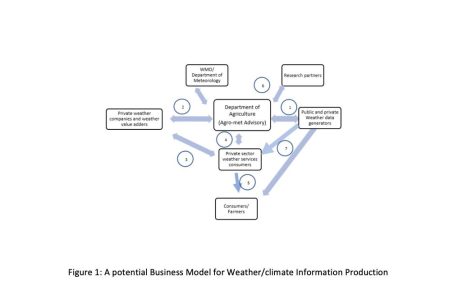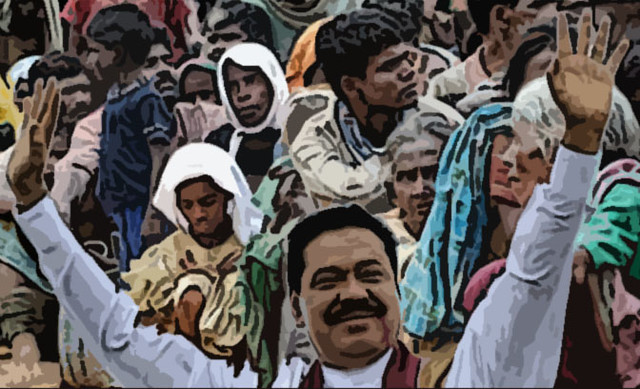As climate emergencies intensify their impacts across the globe, more vulnerable nations like Sri Lanka need to imagine futures quickly — especially when the impact is felt on food crops and agriculture. Kapila Chinthaka Premarathne discusses a possible public–private business idea to develop more accurate and location-specific climate predictions to help farmers make informed choices on their fields for future security and prosperity.
Recent turbulences in the climate due the global warming has altered regular/cyclical climate events in Sri Lanka. In particular, monsoonal rainfall patterns that impact rice production has changed a lot, directly affecting farmers’ livelihoods.
Weather/climate information creates certainty and confidence in farmers’ minds: the ‘expected utility’ helps them to use other inputs during crop production. No studies have been conducted in Sri Lanka to find out the impact of the expected utility that derives from weather/climate information by paddy farmers or how the exact nature of weather/climate information use impacts farmer behaviour.
Against this backdrop, this post suggests (from collaborative research) the potential for developing location specific weather/climate information product packages by examining their use, and user expectations, especially the importance of creating a public–private partnership to provide accurate weather/climate information to support paddy farmers’ decisions.
Usually, Sri Lankan farmers use traditional or scientific weather/climate information to forecast climate change. But the impact of climate change in Sri Lanka is varied across the country, not captured by these knowledge systems. For instance, rainfall is predicted to decrease across most of Sri Lanka, and the first two months of the year (January–February) are likely to be most affected, with the rains ending much earlier, which will require more irrigation for paddy. And the country sadly expects more extreme climate change impacts in the future: The Global Climate Risk Index named Sri Lanka as the fourth most vulnerable nation to climate change in 2016.
The current practice of weather/climate information dissemination is limited to general predictions over a large area due to limited technical capacity or practical issues of dissemination of information. For instance, the Department of Meteorology provides weather/climate information to the Department of Agriculture to disseminate via established channels to farmers in different areas. Meanwhile, the predictive power of traditional weather/climate forecast on regular climate/weather events is declining due to impacts of climate change. These disadvantageous conditions have created new issues like:
- Avoiding regular use of weather information due to lack of reliability;
- Limitations of selecting optimal cultivations (crop varieties that are ideal for the season);
- Lack of information/knowledge to clearly explain how to manage crops;
- Poor attitude towards weather predictions and its uses;
- Insufficient awareness of use of weather information as an input in agriculture;
- Unavailability of customised weather information packages.
The Study and Findings
What is the best way to equip and guide paddy farmers to prepare them for future climate change? To understand this question, a research study was conducted with 900 farmers between 2016–18 representing all paddy farming systems in Sri Lanka. The data analysis was done using a behavioural model, a quasi-experiment (ex-post valuation study) and typical survey data analysing practices. Some of its main findings were:
- There is a gap in the dissemination of information with respect to major crop management events such as irrigation, planting and harvesting from the paddy farmers’ points of view.
- This gap in scientific weather/climate information has led them to use traditional weather/climate predictions.
- However (and as explained by the farmers), the traditional predictions are not complete, even if they continue to use them due to familiarity among the farming communities for centuries.
The results of the behaviour model based on the Theory of Planned Behaviour (TPB) showed that the change of behavioural beliefs such as attitude, intention, perceived difficulties, and reliability are essential to determine or alter the use of the two existing weather/climate information systems. Thus, correct interventions such as extension, training, awareness-building, publicity, and easy access by farmers are required when promoting relevant weather information packages specifically designed to cater to future climate turbulences.
The provision of location-specific weather/climate information was found to be effective, since (as mentioned above) it provides the highest expected utility as estimated by the CRRA utility function. As per this derived expected utility-based input selection, a significant difference in paddy yields was observed which could assume that location-specific weather/climate information has made (paddy) farmers more low-risk averse.
There were limitations to the study, of course. Due to secondary data limitation at the micro-level in Sri Lanka, primary data for only two seasons has been used in the study. Further research is needed to capture the impacts of other variables (like price fluctuations, advanced risk elicitation tools, impacts of other inputs, and technology).
Policy Implications to start Private–Public Weather Businesses
Provision of location-specific customised weather/climate information packages supports the rational use of crop production factors by paddy farmers. But such weather information customisation is not available in Sri Lanka, though tailor-made climate information products are used in other countries where Regional Climate Downscaling (RCD) techniques are used to remove the scale mismatch between existing weather forecasting and location-specific information needs. Thus, revenue-generating opportunities through tailored weather/climate information products would be a potential business. In several countries in Africa, location-specific weather information is sent to non-smart mobile phones (feature phones) after building trust and user confidence via research. In such scenarios, information technology and human expertise have been linked, creating new business opportunities.
However, predicting regional-level weather/climate has some practical limitations, mainly due to more accurate meteorological data requirements for model calibrations. Some of this has been overcome through a combination of contemporary science, new methodologies and traditional knowledge, for instance, through the use of mobile apps, AI and machine learning (e.g., use free weather databases to train models to predict climate). Recently, the application of machine-learning in the Sri Lankan context also has been examined under the new research activities, showing the future potential of weather/climate forecasting, including predictions at regional levels.
As a policy recommendation, this proposal therefore suggests the use of both existing and new knowledge and useful resources in the field of meteorology for developing a new public–private weather/climate information business in Sri Lanka. For instance, private companies can use basic public hydro-meteorological data and common hydro-meteorological data to produce useful weather/climate information for farmers.
Therefore, a business model (Figure 1) which has seven basic business interactions can be developed in Sri Lankan context. The practicability of this kind of business model is evident by examining the Market Assessment Revenue-Generating Opportunities Through Tailored Weather Information Products of UNDP.

In conclusion, then, the importance of customised weather information product initiations in Sri Lanka to fill the information gap which provides high expected utilities over weather/climate risks is crucial. Such high expected utilities allow them to fully utilise the factors of paddy crop production targeting high incomes. It is also a viable new business opportunity which needs to develop, selecting the correct interventions to change the behavioural beliefs of farmers via extension, training, awareness-building and promotion.
*
The views expressed here are those of the author and do not represent the views of the ‘South Asia @ LSE’ blog, the LSE South Asia Centre or the London School of Economics and Political Science. Please click here for our Comments Policy.
This blogpost may not be reposted by anyone without prior written consent of LSE South Asia Centre; please e-mail southasia@lse.ac.uk for permission.
Banner image © Indika Sriyan, ‘A farmer takes a break from working in a rice paddy [field]’, Ambanpola, 2022, Unsplash.
*







